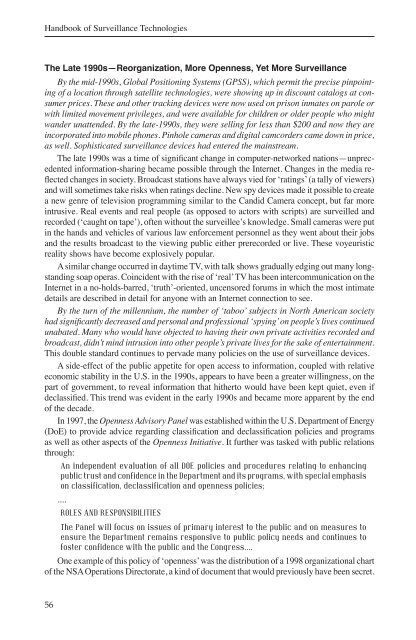Handbook of Surveillance Technologies (3rd Ed) - The Real Faces of ...
Handbook of Surveillance Technologies (3rd Ed) - The Real Faces of ...
Handbook of Surveillance Technologies (3rd Ed) - The Real Faces of ...
You also want an ePaper? Increase the reach of your titles
YUMPU automatically turns print PDFs into web optimized ePapers that Google loves.
<strong>Handbook</strong> <strong>of</strong> <strong>Surveillance</strong> <strong>Technologies</strong><br />
<strong>The</strong> Late 1990s—Reorganization, More Openness, Yet More <strong>Surveillance</strong><br />
By the mid-1990s, Global Positioning Systems (GPSS), which permit the precise pinpointing<br />
<strong>of</strong> a location through satellite technologies, were showing up in discount catalogs at consumer<br />
prices. <strong>The</strong>se and other tracking devices were now used on prison inmates on parole or<br />
with limited movement privileges, and were available for children or older people who might<br />
wander unattended. By the late-1990s, they were selling for less than $200 and now they are<br />
incorporated into mobile phones. Pinhole cameras and digital camcorders came down in price,<br />
as well. Sophisticated surveillance devices had entered the mainstream.<br />
<strong>The</strong> late 1990s was a time <strong>of</strong> significant change in computer-networked nations—unprecedented<br />
information-sharing became possible through the Internet. Changes in the media reflected<br />
changes in society. Broadcast stations have always vied for ‘ratings’ (a tally <strong>of</strong> viewers)<br />
and will sometimes take risks when ratings decline. New spy devices made it possible to create<br />
a new genre <strong>of</strong> television programming similar to the Candid Camera concept, but far more<br />
intrusive. <strong>Real</strong> events and real people (as opposed to actors with scripts) are surveilled and<br />
recorded (‘caught on tape’), <strong>of</strong>ten without the surveillee’s knowledge. Small cameras were put<br />
in the hands and vehicles <strong>of</strong> various law enforcement personnel as they went about their jobs<br />
and the results broadcast to the viewing public either prerecorded or live. <strong>The</strong>se voyeuristic<br />
reality shows have become explosively popular.<br />
A similar change occurred in daytime TV, with talk shows gradually edging out many longstanding<br />
soap operas. Coincident with the rise <strong>of</strong> ‘real’ TV has been intercommunication on the<br />
Internet in a no-holds-barred, ‘truth’-oriented, uncensored forums in which the most intimate<br />
details are described in detail for anyone with an Internet connection to see.<br />
By the turn <strong>of</strong> the millennium, the number <strong>of</strong> ‘taboo’ subjects in North American society<br />
had significantly decreased and personal and pr<strong>of</strong>essional ‘spying’ on people’s lives continued<br />
unabated. Many who would have objected to having their own private activities recorded and<br />
broadcast, didn’t mind intrusion into other people’s private lives for the sake <strong>of</strong> entertainment.<br />
This double standard continues to pervade many policies on the use <strong>of</strong> surveillance devices.<br />
A side-effect <strong>of</strong> the public appetite for open access to information, coupled with relative<br />
economic stability in the U.S. in the 1990s, appears to have been a greater willingness, on the<br />
part <strong>of</strong> government, to reveal information that hitherto would have been kept quiet, even if<br />
declassified. This trend was evident in the early 1990s and became more apparent by the end<br />
<strong>of</strong> the decade.<br />
In 1997, the Openness Advisory Panel was established within the U.S. Department <strong>of</strong> Energy<br />
(DoE) to provide advice regarding classification and declassification policies and programs<br />
as well as other aspects <strong>of</strong> the Openness Initiative. It further was tasked with public relations<br />
through:<br />
An independent evaluation <strong>of</strong> all DOE policies and procedures relating to enhancing<br />
public trust and confidence in the Department and its programs, with special emphasis<br />
on classification, declassification and openness policies;<br />
....<br />
ROLES AND RESPONSIBILITIES<br />
<strong>The</strong> Panel will focus on issues <strong>of</strong> primary interest to the public and on measures to<br />
ensure the Department remains responsive to public policy needs and continues to<br />
foster confidence with the public and the Congress....<br />
One example <strong>of</strong> this policy <strong>of</strong> ‘openness’ was the distribution <strong>of</strong> a 1998 organizational chart<br />
<strong>of</strong> the NSA Operations Directorate, a kind <strong>of</strong> document that would previously have been secret.<br />
56



